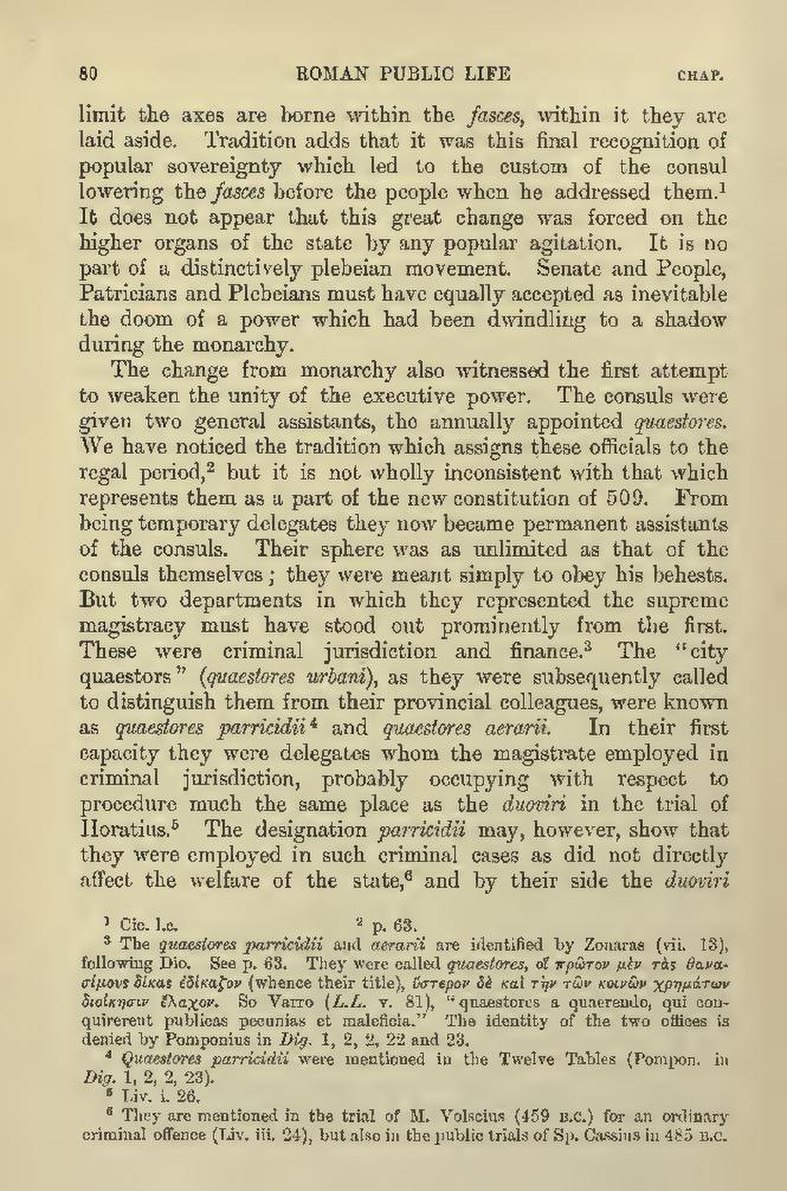limit the axes are borne within the fasces, within it they are laid aside. Tradition adds that it was this final recognition of popular sovereignty which led to the custom of the consul lowering the fasces before the people when he addressed them.[1] It does not appear that this great change was forced on the higher organs of the state by any popular agitation. It is no part of a distinctively plebeian movement. Senate and People, Patricians and Plebeians must have equally accepted as inevitable the doom of a power which had been dwindling to a shadow during the monarchy. The change from monarchy also witnessed the first attempt to weaken the unity of the executive power. The consuls were given two general assistants, the annually appointed quaestores. We have noticed the tradition which assigns these officials to the regal period,[2] but it is not wholly inconsistent with that which represents them as a part of the new constitution of 509. From being temporary delegates they now became permanent assistants of the consuls. Their sphere was as unlimited as that of the consuls themselves; they were meant simply to obey his behests. But two departments in which they represented the supreme magistracy must have stood out prominently from the first. These were criminal jurisdiction and finance.[3] The "city quaestors" (quaestores urbani), as they were subsequently called to distinguish them from their provincial colleagues, were known as quaestores parricidii[4] and quaestores aerarii. In their first capacity they were delegates whom the magistrate employed in criminal jurisdiction, probably occupying with respect to procedure much the same place as the duoviri in the trial of Horatius.[5] The designation parricidii may, however, show that they were employed in such criminal cases as did not directly affect the welfare of the state,[6] and by their side the duoviri(whence their title), [Greek: hysteron de kai tên tôn koinôn chrêmatôn dioikêsin elachon]. So Varro (L.L. v. 81), "quaestores a quaerendo, qui conquirerent publicas pecunias et maleficia." The identity of the two offices is denied by Pomponius in Dig. 1, 2, 2, 22 and 23.]*
- ↑ Cic. l.c.
- ↑ p. 63.
- ↑ The quaestores parricidii and aerarii are identified by Zonaras (vii. 13), following Dio. See p. 63. They were called quaestores, [Greek: hoi prôton men tas thanasimous dikas edikazon
- ↑ Quaestores parricidii were mentioned in the Twelve Tables (Pompon. in Dig. 1, 2, 2, 23).
- ↑ Liv. i. 26.
- ↑ They are mentioned in the trial of M. Volscius (459 B.C.) for an ordinary criminal offence (Liv. iii. 24), but also in the public trials of Sp. Cassius in 485 B.C.
